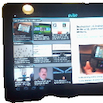It’s been about two weeks since I attended Consumer Electronics Week at NYC, watched 3D TV on big screens and small, and met with local TV entrepreneur Jack Perry. TV is still very much on my mind.
Perry’s company Syncbak provides a new revenue source for local TV stations and network affiliates: retransmitting their content over the Internet, but only to subscribers in the local viewing area.
And I should add, this is a less contentious source of revenue, say compared to retransmitting a TV signal over a cable network.
During the weekend, I learned from The New York Times that a Fox affiliate in the Ozarks couldn’t come to terms with the Fox parent company. At issue was KSFX’s (Springfield, Missouri) own retransmission agreement with an unnamed cable operator.
Fox wanted a greater cut of the revenue that KSFX receives for allowing its signal (local news and Fox programming) to be seen by cable viewers.Continue reading



 I couldn’t resist.
I couldn’t resist. I missed the New York Tech Meetup on Tuesday and didn’t get to hear a presentation from the New York State Senate’s information officers.
I missed the New York Tech Meetup on Tuesday and didn’t get to hear a presentation from the New York State Senate’s information officers.